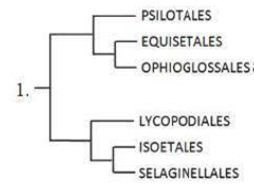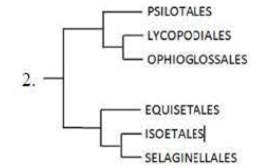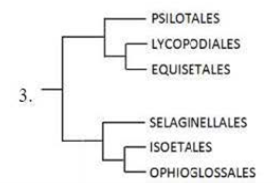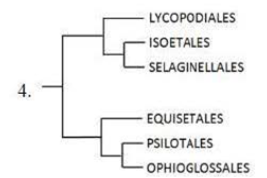Performance Meter
0%
QUESTION ID:1
QUESTION ID:2
QUESTION ID:3
QUESTION ID:4
Column X | Column Y | ||
| A. | Anchoring junction | i. | Claudins |
| B. | Occluding junction | ii. | Delta-Notch |
| C. | Channel-forming junction | iii. | Desmoglein |
| D. | Signal-relying junction | iv. | Connexin |
QUESTION ID:5
QUESTION ID:6
QUESTION ID:7
QUESTION ID:8
QUESTION ID:9
QUESTION ID:10
QUESTION ID:11
QUESTION ID:12
QUESTION ID:13
QUESTION ID:14
QUESTION ID:15
QUESTION ID:16
QUESTION ID:17
QUESTION ID:18
QUESTION ID:19
QUESTION ID:20
QUESTION ID:21
QUESTION ID:22
QUESTION ID:23
QUESTION ID:24
QUESTION ID:25
QUESTION ID:26
QUESTION ID:27
QUESTION ID:28
QUESTION ID:29
QUESTION ID:30
QUESTION ID:31
QUESTION ID:32
Which one of the following functions is NOT facilitated by a tmRNA?
QUESTION ID:33
QUESTION ID:34
QUESTION ID:35
QUESTION ID:36
QUESTION ID:37
QUESTION ID:38
QUESTION ID:39
QUESTION ID:40
QUESTION ID:41
Choose the INCORRECT statement
QUESTION ID:42
QUESTION ID:43
Which cell cycle phase is typically the shortest in mammalian cells?
QUESTION ID:44
QUESTION ID:45
QUESTION ID:46
QUESTION ID:47
QUESTION ID:48
QUESTION ID:49
QUESTION ID:50
QUESTION ID:51
QUESTION ID:52
QUESTION ID:53
QUESTION ID:54
Following statements were made about mRNA splicing:
A. Involvement of a cis-acting branchpoint site (or branchpoint sequence) present near 3' end of each exon is essential for splicing.
B. In the first step of splicing reaction, 2'-0H of the conserved U at the branch-site acts as a nucleophile to attack the plhosphoryl group of the conserved Gin the 5' splice site.
c. The newly liberated intron adapts shape ot a lariat due to joining ot the 5' end of the intron to the branch point
D. During the splicing process, there is no net gain in the number of chemical bonds
E. Prp22 (a DEAD-box helicase) is required for stripping the spliced mRNA from the spliceosome
Which one of the following options shows combination of all correct statements?
QUESTION ID:55
QUESTION ID:56
QUESTION ID:57
QUESTION ID:58
QUESTION ID:59
QUESTION ID:60




QUESTION ID:61
QUESTION ID:62
QUESTION ID:63
QUESTION ID:64
QUESTION ID:65
QUESTION ID:66
QUESTION ID:67
QUESTION ID:68
QUESTION ID:69
QUESTION ID:70
QUESTION ID:71
QUESTION ID:72
QUESTION ID:73
QUESTION ID:74
QUESTION ID:75
Column X | Column Y |
A. Auxins | i. Geranylgeranyl diphosphate |
B. Cytokinins | ii. Adenosine moiety |
C. Ethylene | iii. Tryptophan |
D. Gibberellins | iv. 1-aminocyclopropane 1-carboxylic acid |
QUESTION ID:76
QUESTION ID:77
QUESTION ID:78
QUESTION ID:79
Column X | Column Y | ||
| A. | Typological species concept | i. | Single lineage of ancestor-descendant populations which maintains its identity from other such lineages |
| B. | Biological species concept | ii. | A species is a set of organisms that resemble one another and is distinct from other sets. |
| C. | Evolutionary species concept | iii. | Species are groups of interbreeding natural populations that are reproductively isolated from other such groups |
| D. | Phylogenetic species concept | iv. | A group recognised by its monophyly |
QUESTION ID:80
QUESTION ID:81
QUESTION ID:82
QUESTION ID:83
QUESTION ID:84
QUESTION ID:85
QUESTION ID:86
Column X | Column Y | ||
| A. | Mangroves | i. | Western Ghats |
| B. | Terai | ii. | Banni |
| C. | Laterite plateaus | iii. | Sunderbans |
| D. | Arid grasslands | iv. | Himalayan foothills |
| E. | Shola |
QUESTION ID:87
Column X | Column Y | ||
| A. | Lactate dehydrogenase | i. | Lysosomes |
| B. | Acid phosphatase | ii. | Microsomes |
| C. | Glucose-6-phosphatase | iii. | Cytosol |
| D. | Catalase | iv. | Peroxisomes |
QUESTION ID:88
QUESTION ID:89
QUESTION ID:90
QUESTION ID:91
QUESTION ID:92
QUESTION ID:93
QUESTION ID:94
QUESTION ID:95
QUESTION ID:96
QUESTION ID:97
QUESTION ID:98
Method (Column X) | Description (Column Y) | ||
| A. | Maximum parsimony | i. | Tree length, that is sum of branch lengths, often estimated by least squares. |
| B. | Minimum evolution | ii. | Minimum number of changes, minimised over ancestral states |
| C. | Bayesian | iii. | Cluster algorithms to arrive at a single tree. |
| D. | Neighbour Joining | iv. | Posterior probability, calculated by integrating it over branch lengths and substitution parameters |
QUESTION ID:99
QUESTION ID:100
QUESTION ID:101
QUESTION ID:102
QUESTION ID:103
QUESTION ID:104
QUESTION ID:105
QUESTION ID:106
QUESTION ID:107
QUESTION ID:108
QUESTION ID:109
Selected human diseases and their vectors are listed below:
Which one of the following options represents the correct match between column X and column Y?
QUESTION ID:110
QUESTION ID:111
QUESTION ID:112
QUESTION ID:113
QUESTION ID:114
QUESTION ID:115
QUESTION ID:116
QUESTION ID:117
QUESTION ID:118
QUESTION ID:119
QUESTION ID:120
QUESTION ID:121
QUESTION ID:122
QUESTION ID:123
QUESTION ID:124
QUESTION ID:125
QUESTION ID:126
QUESTION ID:127
QUESTION ID:128
QUESTION ID:129
 TLS Online
TLS Online